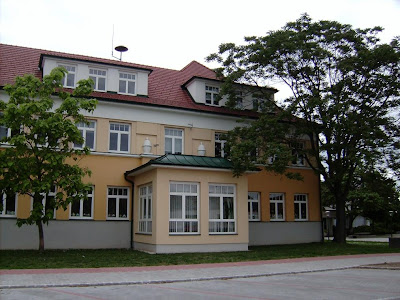We went into Hungary again yesterday and did more exploring in Old Town. Before that, however, we went to the Total Beauty Center in Sopron Plaza. It's a typical modern mall with shops, kiosks, restaurants and cafes and, more to the point for us, a beauty salon/spa. They do haircuts, lots of hair dyeing, massages, waxing, manicures and pedicures, which is what we wanted. There is a large main area and several smaller rooms. The manicure was pretty typical, but there were some differences in the pedicure. First, you go into this room about 25 feet long by about 8 feet wide. Along one long wall is an elevated row of seven chairs for the pedicures. They look more like dentist office chairs, and the backs, seats and arms are covered with form-fitting white terry cloth. At the front of each seat folded down are leg extenders also covered with white terry cloth. The girls sit on office-style swivel chairs and move the extenders up and down wherever they want your feet. Everyone who works there wears white shirts and slacks, style according to their choice. And no one wears a white bra under her shirt - I saw black, pink, green, turquoise and yellow but no white or neutral. They all wear lots of jewelry, including extra ear rings, nose and eyebrow studs and necklaces.
Five women worked in the pedicure area, and I can now state that a bunch of women chattering in Hungarian doesn't sound that different from Vietnamese - you still can't understand a word they say! It also makes you wonder if you want to get your hair done there after you see the workers' hair. Odd, assymetrical cuts, spiky, bright color patches and streaks, all the kinds of things that discourage me from letting them touch my hair.
After you make your appointment, you wait in a lounge area just outside the salon area. You can see everything going on in the salon through the glass walls. Servers come around and take drink orders, and many people enjoy wine or beer while waiting. Also, women with foil strips in their hair sit out there and enjoy a drink while waiting for the color to take. All in all, we found it an interesting experience and about the same price as in America.
Then we went into Old Town in Sopron. I'd never heard of the town before, but it is a very old city. Founded in Roman times, it was a thriving community during the medieval period. The city suffered terribly during World War II due to Nazi bombing and atrocities and later from Soviet occupation. Today it has a population of about 53,000. The hardest part for us is that we would see an obviously very old building that might be a museum, but there are no signs in English (like you often see in Austria) and no arrows pointing to museums. The only way we found the Fire Tower and churches was to see the spires and walk through the streets till we found them.
The Fire Tower is the symbol of Sopron. The foundations are Roman, and it was added to during the medieval period, Renaissance and later Baroque eras. We were going to go into the Fire Tower Museum but didn't have any florins - they didn't take Euros - so we'll do that another day.
Roman Era foundation at entrance to Fire Tower


Different Views of the Fire Tower



Benedictine Church

On the wall on the right side of the aisle

The altar

This is a private home. Many of the houses have a lintel
with the building date above the front door.

Another church with protective Roman Era wall



This is the World War II memorial. On the other side
there was a bronze helmet that looked a lot like the
German helmet of that era and a bouquet someone had
placed at the foot. Note the Hungarian flag - we saw
many flags and wondered if it was a holiday akin to
our Memorial Day.

We love the old cobblestones. Note that the pigeons
completely ignore Bob - that's his shadow.

Another Roman Era wall

I guess there are some disadvantages to living in the
picturesque Old Town.

The Sopron Post Office

This Opera or Music House is famous. Sopron was
the home of many composers, including Franz Liszt.























































